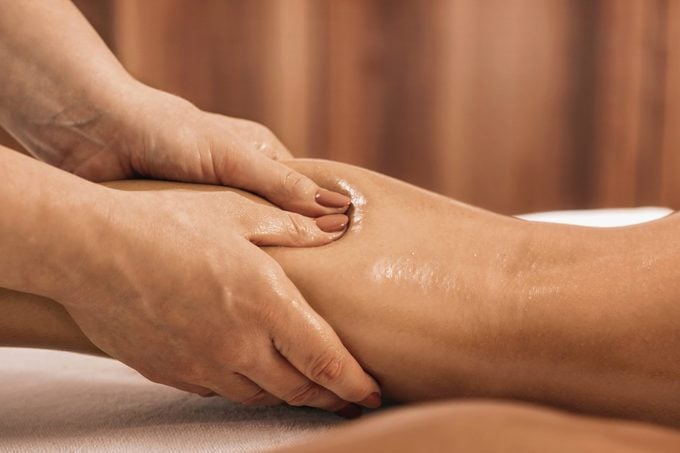What Lymphatic Drainage Massage Can and Can’t Do for Your Body
Updated: Apr. 05, 2021
Lymphatic drainage massages can help move fluid from the body's tissues back into the bloodstream. Here's how they work and why people get them.
A different type of massage
It’s a mouthful—manual lymphatic drainage massage—and its purpose is a bit complex, too. Manual lymphatic drainage is a type of massage that uses light pressure to move fluid through your body and back into your bloodstream.
It’s done by a qualified specialist and can target certain health concerns or be used as a general wellness treatment, says Jeanette Zucker, a physical therapist at the Memorial Sloan Kettering Cancer Center in New York, who specializes in lymphedema therapy.
Here’s everything you need to know about a lymphatic drainage massage.
Understanding the lymphatic system
Most people have heard of lymph nodes but you might not realize just how widespread the lymphatic system is throughout the body. The lymphatic system includes a network of vessels that move lymph—a clear or whitish fluid—from the body’s tissues back to the bloodstream. Among other things, lymph carries white blood cells, nutrients from digestion (like fats and proteins), and cellular waste.
As it moves through the lymphatic system, lymph is filtered by the lymph nodes. The lymphatic system, which also includes the spleen, thymus, and bone marrow, is part of your immune system and helps fight infections as well as rid the body of toxins and waste.
Sometimes the body struggles to move this fluid on its own, which is where manual lymphatic drainage comes in.
“The goal of manual lymphatic drainage is to bring all this lymphatic fluid back its normal path—which mean going back into the venous angles [a junction of veins near the neck] and from there the blood is filtered by your kidneys and you urinate out the extra fluid,” says Zucker.
Who should get a lymphatic drainage massage?
There are a number of medical reasons to get manual lymphatic drainage massage.
“This treatment is appropriate for anybody that has any sort of edema, or swelling, in various parts of the body because there isn’t adequate lymphatic flow,” says Chris Wilson, a clinical massage therapist at the Osher Center for Integrative Medicine at Northwestern University.
This type of swelling is called lymphedema.
Cancer
When the treatment for cancer involves the removal of lymph nodes, this impacts the lymphatic system. “They don’t regenerate,” says Wilson. “The lymphatic flow will now have to find another path.”
For example, breast cancer patients often have lymph nodes in the armpit removed. That’s because cancer cells can travel in lymph, and lymph nodes in the armpit are one of the first spots where breast cancer cells can spread.
Once those lymph nodes are removed, lymphedema can occur. One study found 42 percent of breast cancer patients reported lymphedema at some point in the five years after treatment, although symptoms were usually mild. It can cause swelling, aching, and a loss of flexibility in the arm on the same side of the body that the cancer occurred.
Manual lymphatic drainage massage is considered safe for breast cancer patients with lymphedema, although it’s often used in combination with other treatments including compression garments and exercise.
Surgery
Manual lymphatic drainage can help with the swelling that occurs after surgery, such as orthopedic surgery or plastic surgery, says Zucker.
A 2017 study in The Journal of Craniofacial Surgery found a faster reduction in swelling in patients who had manual lymphatic drainage after jaw surgery.
“It facilitates the healing process because a very common side effect of surgery is postoperative swelling,” says Zucker.
Primary lymphedema
Sometimes lymphedema is due to a condition you are born with, rather than a surgery or cancer. This is called primary lymphedema.
It’s a rare condition where fluid collects in certain tissues, causing swelling in parts of your body.
Wellness and cosmetics
Lymphatic drainage massage is also commonly be used for general wellness or for cosmetic reasons, like bloat, cellulite, and rosacea. Both Wilson and Zucker say, from their experience, that the therapy can be effective for these reasons.
There is not a lot of scientific evidence to back that up, although a 2010 study in the Journal of The European Academy of Dermatology and Venerology on 60 women with cellulite found manual lymphatic drainage (as well as two other massage techniques) reduced fat and thigh circumference by about 1 to 3 millimeters.
Who shouldn’t get lymphatic drainage massage
Manual lymphatic drainage is generally a safe treatment, but for some people, it could be harmful.
“You need to make sure that you’re medically cleared to receive it,” says Zucker.
People with the following conditions should not receive manual lymphatic drainage treatments:
- heart conditions, like heart failure
- kidney failure
- blood clots
- infections
In addition, people shouldn’t get manual lymphatic drainage on their abdomen if they are pregnant, or have certain conditions including irritable bowel syndrome, abdominal aortic aneurism, diverticulosis, and diverticulitis, says Zucker. Again, check with a doctor if you’re unsure.

What is a lymphatic drainage massage session like?
Manual lymphatic drainage is performed by a practitioner with a certification in the practice, known as a certified lymphedema therapist (CLT). The practitioner is typically a physical therapist, massage therapist, or occupational therapist.
During your session, the therapist will use a gentle motion to stretch the skin. “When you stretch the skin, you’re basically creating negative pressure in the sense that you pull up the skin and there’s another space there, and that encourages the fluid to move along,” says Zucker.
The practitioner will move from the area closest to the heart and then move outward to the extremities, always encouraging the fluid to move back towards the venous angles.
“We divide the body into four different watersheds—left and right; top and bottom. For example, from our umbilical upward, there is a different flow on that part of our body than the lower torso,” explains Wilson.
Manual lymphatic drainage sessions last 30 minutes to an hour and frequency varies depending on the condition you are targeting. People with chronic lymphedema need to do manual lymphatic drainage daily, says Zucker, and are taught how to do it themselves at home.
Wilson says his patients typically feel good after the treatment. “The best thing that happens after we have a lymphatic treatment is elimination—going pee or poop. Anytime we’re not doing that, we’re holding toxins.”
The last word
A lymphatic drainage massage is a reputable treatment for certain conditions where the lymphatic system is compromised and it might help for cosmetic reasons as well. Be sure to check with your doctor before starting manual lymphatic drainage treatment.



